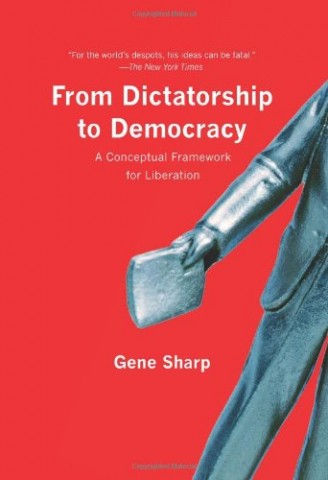From Dictatorship to Democracy
One of the world's leading thinkers and activists for advancing democratic governance through non-violent action is Gene Sharp. He founded the Albert Einstein Institute and is a multiple-time nominee for the Nobel Peace Prize, as well as recipient of many other notable awards. He has authored many books, but one of his most influential and most widely translated books, as well as one of the most widely referred to books by non-violent activists, is "From Dictatorship to Democracy: A Conceptual Framework for Liberation" (1993, original). Famously, the book includes a list of 198 methods of non-violent action.
Sharp writes in the preface to the book that "the focus of this essay [it was originally written as a series for activists] is on the generic problem of how to destroy a dictatorship and to prevent the rise of a new one" (p. xix). At the outset, the author makes clear that in most instances of dictatorship, violent action will not work: "Whatever the merits of the violent option, however, one point is clear. By placing confidence in violent means, one has chosen the very type of struggle with which the oppressors nearly always have superiority" (p. 6). The alternative advocated by Sharp is non-violent action.
How? Quite succinctly, the author summarizes (p. 12): "When one wants to bring down a dictatorship most effectively and with the least cost then one has four immediate tasks:
- One must strengthen the oppressed population themselves in their determination, self-confidence, and resistance skills;
- One must strengthen the independent social groups and institutions of the oppressed people;
- One must create a powerful internal resistance force;
- One must develop a wise grand strategic plan for liberation and implement it skillfully."
Navigating the actions and reactions of a dictatorial government and its supporters requires close monitoring and analysis. Sharp does not delve into the academics of the matter, and summarizes the key factors relating to success as: "(1) the relative desire of the populace to impose limits on the government's power; (2) the relative strength of the subjects' independent organizations and institutions to withdraw collectively the sources of power; and (3) the population's relative ability to withhold their consent and assistance" (p. 33).
The book is not all positivity and encouragement. There are strong warnings about the costs as well as the responsibilities involved. For example, even "when the oppressive system was brought down, lack of planning on how to handle the transition to a democratic system has contributed to the emergence of a new dictatorship" (p. 61). In other words, all the action and all the costs can re-create the system that was fought against if long term, strategic planning is not a part of the struggle. Furthermore, Sharp emphasizes not just the planning of power, but the re-distribution of it: "The effect of nonviolent struggle is not only to weaken and remove dictators but also to empower the oppressed. This technique enables people who formerly felt themselves to be only pawns or victims to wield power directly in order to gain by their own efforts greater freedom and justice… One important long-term beneficial consequence of the use of nonviolent struggle for establishing democratic government is that the society will be more capable of dealing with continuing and future problems… The population experienced in the use of political defiance is less likely to be vulnerable to future dictatorships." (p. 121-122).
